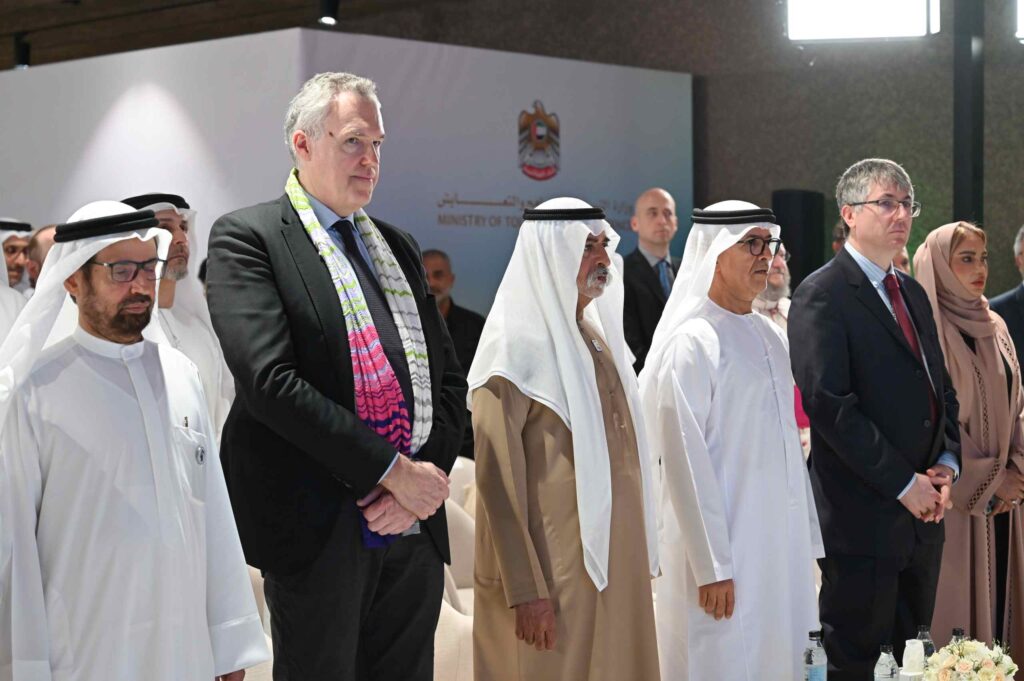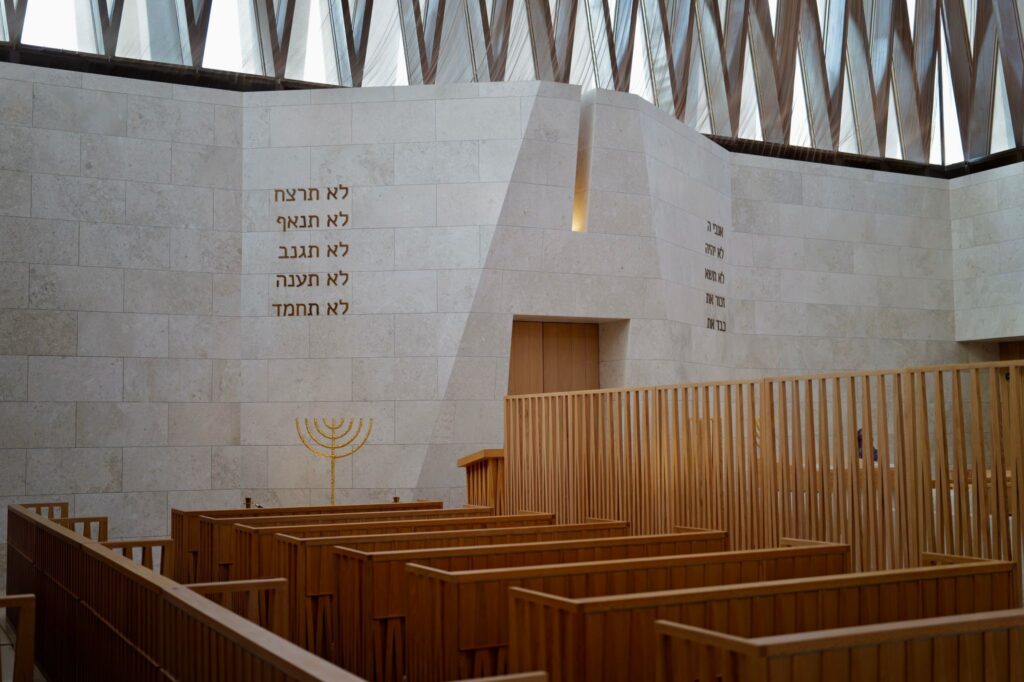Inside the Abrahamic Family House
A Church, a Synagogue and a Mosque together in one space, can that work? And what is it good for? When the building of the Abrahamic Family House in Abu Dhabi was announced in 2019, many were skeptical of the idea. In February 2023, the interreligious complex was finally opened to the public. The “First Intercultural and Interreligious Dialogue Forum” between Austria and the United Arab Emirates, celebrated on 13 November 2024, was the first event of that kind held at the Abrahamic Family House. It offered an insight into the work of the institution, the dedication of the UAE to tolerance and coexistence, and a possibility for a first exchange on practices of dialogue in Austria and the Emirates. Moreover, the participants could identify common challenges of the respective cultures and religions, especially in peace diplomacy, social cohesion, and technology.

A Performance of Mutual Entanglement
The complex of the Abrahamic Family House cannot be understood without its intrinsic connection to the Document on Human Fraternity, signed by Pope Francis and Grand Imam al-Tayyeb. The building was announced shortly after the signing in February 2016. Located at Saadiyat Island in Abu Dhabi, the Abrahamic Family House consists of a Catholic Church, a Synagogue, and a Mosque. All are the same size and situated in a garden-like area. They are all on the same level and connected via footpaths. In the underground, one finds large parking lots and an extensive conference and educational area.
The three religious buildings share a similar architectural message based on an interplay of water, light, and stone, but each of them interprets these elements within the framework of their respective faith tradition. It is an interplay of particularity and similarity, a carefully reflected performance of Abrahamic entanglement while appreciating the respective differences of the religious traditions without normatively judging them. Visiting the complex, one feels the deep connectedness of the Jewish, Christian, and Muslim traditions – one cannot really be without the other, each religious building is part of the specific Abrahamic dynamics that the buildings symbolize.
Designed by Ghanaian-British architect David Adjaye and his design firm, the complex is an architectural interpretation of the basic message of the Document on Human Fraternity, namely human fraternity and its rootedness in the three Abrahamic faiths. No surprise, the Document is prominently featured in the educational area of the AFH. The deep connection with the Document is also indicated by the names given to the Church and the Mosque: St Francis Church, dedicated to St Francis of Assisi, a pioneer of dialogue and patron to Pope Francis, and Imam Al-Tayyeb Mosque, remembering the Muslim signatory of the Document, Grand Imam al-Tayyeb. The Synagogue bears the name of Moshe Ben Maimon, one of the greatest minds of mankind, a key figure in Jewish tradition, deeply revered as “RamBaM” and a bridge between Islamic, Jewish, and Christian philosophical and theological thinking.
The outer structure of St Francis Church consists of large white square columns. When the sun rises, the Church is fully illuminated. Particularly strong is the symbol of the broken marble ambo – the word of God is more solid than stone. The ceiling is covered with a complex wooden structure that covers the visitor like a comforting tent. Visiting the Church, one must not oversee the marvelous baptistery on the left-hand’s side – a warm, comforting, silent space of total calmness.
The Synagogue Moses Ben Maimon, situated in between the Church and the Mosque, is oriented towards Jerusalem and refers to the Sukka. Its columns represent palm trees, the ceiling reinterprets the top of the Sukka. Jewish communities meet here regularly for prayer. Rabbi David Rosen was highly involved in the construction of the Abrahamic Family House and still regularly advises the work there. The Jewish community in the Emirates is very active, headed by Rabbi Levi Duchman, Main representative of the Chabad-Lubavitch Movement, whom the Austrian delegation was able to visit in person.
The third building, the Imam Al-Tayyeb Mosque, is surrounded by seven high arches. The interior symbolizes the Cave of Hira where Muhammad received the first revelation of the Quran. It seems as if the mosque wanted to invite the visitor to dive into the divine mystery, into another world, a cave, which is beyond human words.
Enlightening Each Other’s Beauty
Each Sunday, the Abrahamic Family House hosts workshops for children, as the Acting Executive Director Abdulla al-Shehhi, points out. About 100 people can participate, and more than 200 more would like to join. The main goal of these workshops is to foster social bonds in the highly plural Emirati society that consists of more than 200 nationalities.
The Abrahamic Family House is no classical tourist side, although any visitor is welcome. It is primarily a place of education, community building, and worship. As Rabbi Rosen says: “To enlighten each other’s beauty goes beyond tolerance and this is what is actually practiced in the Abrahamic Family House. We want to make people walk through the AFH and experience how people of different faiths can and do celebrate in the same campus. If people see each other, they cannot demonize each other anymore.”

Intercultural and Interreligious Dialogue Forum: Sharing Best Practices in Austria and the Emirates
The visit to the Abrahamic Family House took place as part of the First Intercultural and Interreligious Dialogue Forum Between Austria and the UAE. This format was the first kind of official bilateral dialogue hosted in the Abrahamic Family House as part of the National Week of Tolerance and Coexistence of the Emirates. The Forum was officially opened by H.E. Sheikh Nahayan Mabarak Al-Nahyan, the UAE’s minister for tolerance and coexistence. The distinguished guests included the Apostolic Vicar Paolo Martinelli and the Apostolic Nuntius to the United Arab Emirates, Christophe Zakhia El-Kassis, multiple representatives from UAE’s cabinet, and diverse embassies. The Austrian delegation was headed by H.E. Ambassador Christoph Thun-Hohenstein, Vice Minister for Cultural Affairs in the Foreign Ministry, H.E. Etienne Berchtold, Austrian Ambassador to the UAE, and H.E. Alexander Rieger, Head of Intercultural and Interreligious Dialogue in the Foreign Ministry.
In his keynote, Sheikh Nahyan underlined the urgency of sincere cooperation for human fraternity and coexistence: “We are all here together working on peaceful harmony, appreciate each other as human beings in our differences. Dialogue is at the heart of tolerant societies.” The minister referred to the commitment of the Emirati president to peace and the preservation of human dignity and the need for an honest and trustful dialogue for a better and more prosperous world. Facing the broken world, the audience could feel the painful wound of growing conflicts, wars, and devastation. “Why is there no peace despite all the meetings and conferences?”, asked Sheikh Nahyan.
In three mixed Austro-Emirati panels, consisting of religious, academic, and ministerial representatives, the forum discussed the importance of tolerance and ethical synergy, best practice examples of fostering interfaith understanding and cooperation, and the challenge of human-centric digital literacy with a special focus on empowering youth. The participants agreed that sincere dialogue is a challenge, but the essential way to protect human dignity in a fragile world shattered by war and the rise of technologies that are beyond anything we have seen before, especially with the rise of AI and quantum computing. Faith communities and civil societies must play a key role in re-humanizing the world.

Perspectives: The Thirst for Dialogue and Peace
The Emirates are proud of their long-established networks of commerce and collaboration and the cultural and religious plurality of their society. However, living peacefully together in plurality is not self-evident. The Abrahamic Family House is part of a broad educational, social, and political initiative to foster dialogue, tolerance, and understanding among people of diverse traditions. The challenge is to find the balance between universal humanity and appreciation and protection of particularities. On an architectural level, the Abrahamic Family House already celebrates the fragile balance of universalism, commonalities, and particularities. The current difficulty is, how to transform the architectural idea into concrete activities, practices, and a global network of dialogue and understanding.
The global threats to life as such are too serious to play mere games of “dialoguing”. The First Intercultural and Interreligious Dialogue Forum was aware of the existential dimension of dialogue on all levels from the grassroots to the top of international diplomacy. We have no other chance to survive than to take any chance for dialogue and cooperation we can find. And this dialogue must be honest and truthful, aware of our human vulnerabilities and weaknesses, but strong and clear in its vision for a better world for the generations to come. If there are any.
Michaela Quast-Neulinger is an Assistant Professor of Fundamental Theology and Religious Studies at the University of Innsbruck. In November 2024, she participated as a member of the Austrian delegation in the First Intercultural and Interreligious Dialogue Forum between Austria and the United Arab Emirates. She is involved in the V-Theo Islam working group.
All photographs were taken by the author, except where otherwise noted. All rights reserved.
Subscribe to our newsletter




